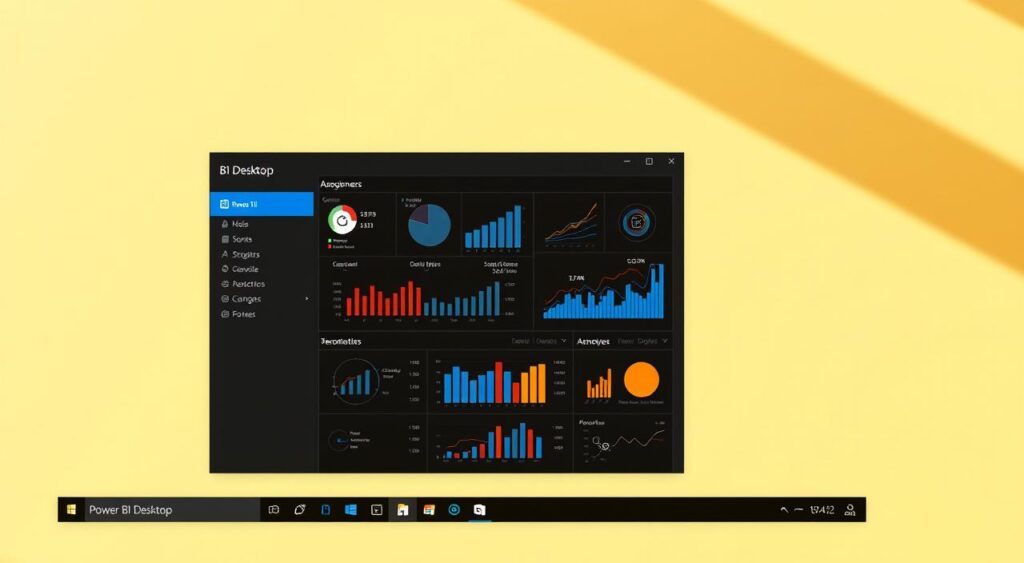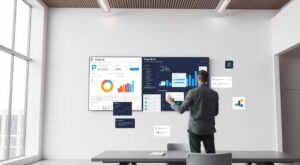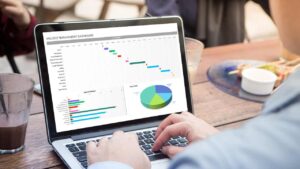
Did you know that businesses using Power BI Desktop do better than others? This tool lets you make interactive visualizations and handle data well. It’s why Power BI Desktop is so popular. Power BI Desktop Download for Windows 11
If you use Windows 11, getting Power BI Desktop can really help with data analysis. It’s made for analysts, offering top-notch visualizations and data handling. We’ll show you how to download Power BI Desktop on your Windows 11, so you can use it to its fullest.
What is Power BI Desktop?
Power BI Desktop turns raw data into useful insights and reports. It’s a tool from Microsoft that lets you link to many data sources. You can also make interactive dashboards and share your findings.
Overview of Power BI Desktop
Power BI Desktop is a free app for making interactive business reports. It has tools to import, change, and model data from various sources. You can then make visualizations and reports to help in business decisions.
You can do many things with Power BI Desktop. This includes getting data, making connections, and enriching your data model. You can also create reports, save them, and publish them to the Power BI service. For more info on Power BI, check out this resource.
Key Features
Power BI Desktop has many important features for data analysis. Some of these include:
- Data Import and Transformation: Link to different data sources, import data, and change it for analysis.
- Data Modeling: Make data models by linking different data sets. This makes complex data easier to analyze.
- Report Creation: Create interactive and attractive reports with various visualization tools.
- Publishing and Sharing: Publish your reports to the Power BI service. They can be shared and accessed from anywhere.
These features, among others, make Power BI Desktop a powerful tool for data analysis. It helps you understand your data better and make informed decisions.
System Requirements for Power BI Desktop Download for Windows 11
Before you install Power BI Desktop on Windows 11, make sure your device is ready. Check if it meets the necessary system requirements.
Minimum Specifications
To use Power BI Desktop on Windows 11, your system needs to have:
- Operating System: Windows 10, Windows 11, Windows Server 2016, or Windows Server 2019.
- Internet Browser: Internet Explorer 10 or later.
- RAM: At least 2 GB available RAM, though 4 GB or more is recommended for better performance.
- Display: A resolution of 1440×900 or higher is recommended for optimal viewing.
- .NET Framework: .NET Framework 4.6.2 or later is required.
Recommended Specifications
For the best experience with Power BI Desktop on Windows 11, consider these recommended specs:
- Processor: A modern CPU with multiple cores (at least a dual-core processor).
- RAM: 4 GB or more, especially if you’re working with large datasets.
- Storage: Adequate disk space for your reports and datasets. Consider using an SSD for faster performance.
- Display: Higher resolutions such as 1920×1080 or higher for better visualization.
Ensuring your system meets these requirements will help you get the most out of Power BI Desktop on Windows 11.
Benefits of Using Power BI Desktop
Power BI Desktop turns raw data into insights that help your business grow. It boosts your data analysis skills. It’s a strong tool for making reports that are both interactive and dynamic.
Data Visualization Capabilities
Power BI Desktop offers top-notch interactive visuals. These help you dive deep into your data. You can pick from many visualization options to make reports that really stand out.
Key Visualization Features:
- Interactive dashboards
- Customizable charts and graphs
- Drill-down capabilities for detailed analysis
Enhanced Decision-Making
Power BI Desktop’s advanced analytics help you make smart choices. It lets you spot trends and patterns. This way, you can find chances and hurdles, guiding your business strategy.
| Decision-Making Aspect | Benefit | Power BI Desktop Feature |
|---|---|---|
| Data-Driven Insights | Informed decision-making | Advanced analytics and reporting |
| Trend Analysis | Identifying opportunities and challenges | Interactive visualizations and drill-down capabilities |
| Strategic Planning | Data-backed strategic decisions | Customizable dashboards and reports |
Using Power BI Desktop on Windows 11 unlocks your data’s full potential. It drives your business forward and boosts success.
How to Download Power BI Desktop
Power BI Desktop is available for download from the official Microsoft website. We’ll guide you through the process.
Downloading Power BI Desktop is easy. It involves a few simple steps. First, visit the Microsoft Power BI website.
Step-by-Step Download Guide
To download Power BI Desktop, follow these steps:
- Go to the Microsoft Power BI Desktop download page.
- Click on the download link for your system’s architecture (32-bit or 64-bit).
- The file names are typically PBIDesktopSetup.exe for 32-bit systems and PBIDesktopSetup_x64.exe for 64-bit systems.
- Once downloaded, run the installer and follow the on-screen instructions.
Direct Link to Microsoft Download Page
For your convenience, you can directly access the Microsoft Power BI Desktop download page to start the download process.
By following these steps, you can easily download and start using Power BI Desktop on your Windows 11 machine.
Installing Power BI Desktop on Windows11
Installing Power BI Desktop on Windows 11 is easy. First, download the installer from the Microsoft website.
Installation Process
To start, follow these steps:
- Run the EXE installer you downloaded.
- Follow the setup steps the installation wizard gives you.
- Accept the terms and choose where to install it.
- Click “Install” to start the installation.
- After it’s installed, click “Finish” to open Power BI Desktop.
The installation is designed to be easy. If you run into problems, see the troubleshooting section below.
Troubleshooting Common Installation Issues
Some users might face issues during installation. Here are common problems and how to fix them:
| Issue | Solution |
|---|---|
| Installer fails to launch | Make sure your Windows 11 is up to date. Try running the installer as an admin. |
| Installation is stuck | Stop the installation and restart your computer. Then, try installing again. |
| Power BI Desktop doesn’t launch after installation | Check if your system meets Power BI Desktop’s minimum requirements. If not, try reinstalling. |
By following these steps, you should fix most installation problems. For more help, visit the Microsoft Power BI community forum.
Setting Up Your First Report
Setting up your first report in Power BI Desktop is easy. It lets you see your data in a new way. With Power BI Desktop on Windows 11, you can dive into your data easily.
Importing Data Sources
To begin, import your data into Power BI Desktop. Go to the Home tab and click “Get Data.” Power BI works with many data sources, like Excel, SQL databases, and Azure.
- Click on “Get Data” from the Home tab.
- Select your data source from the available options.
- Follow the prompts to connect to your data source.
Creating Visualizations
After importing your data, start making visualizations. Power BI Desktop has tools like charts, tables, and maps. These help you show your data well.
- Go to the Report View by clicking on the Report View icon.
- Drag and drop fields from your dataset into the visualization pane.
- Choose the type of visualization that best represents your data.
Here’s a simple example of how different data sources can be visualized:
| Data Source | Visualization Type | Use Case |
|---|---|---|
| Excel Spreadsheet | Bar Chart | Comparing sales data across different regions. |
| SQL Database | Line Chart | Tracking website traffic over time. |
| Azure Service | Map | Visualizing customer locations. |
By following these steps, you can quickly set up your first report in Power BI Desktop. Start gaining insights from your data using the power bi for windows11 download.
Exploring Power BI Desktop Interface
After downloading Power BI Desktop for Windows 11, it’s time to learn its interface. The workspace is easy to use and packed with tools. It helps you make great reports and dashboards.
Overview of the Workspace
The Power BI Desktop interface has key parts for analyzing and showing data. You’ll mainly use:
- Report View: Here, you design reports with various tools and visuals.
- Data View: This is for checking and preparing your data for analysis.
- Relationships View: It helps manage data table connections for complex models.
- Model View: Shows your data model visually, aiding in data structure management.
The Fields pane lists your data fields. The Visualizations pane offers many ways to display your data.
Navigation Tips for Beginners
For newcomers, Power BI Desktop’s interface might seem complex. Here are some tips to help you begin:
- Start with Report View: Begin by making a new report or opening one. It helps you understand the interface’s parts.
- Explore the Ribbon: The top ribbon has tabs with various tools. Get to know the Home, Modeling, and View tabs.
- Use the Fields and Visualizations Panes: These are key for making visuals. Try dragging fields to the canvas to see different visuals.
- Customize Your Workspace: You can change the Power BI Desktop layout to fit your needs. Resize panes and move elements around.
Knowing the Power BI Desktop interface well lets you use it fully for your data analysis.
Integrating Power BI with Other Microsoft Products
Power BI Desktop works well with other Microsoft products. This makes it better for analyzing data. You can use different Microsoft tools together to understand your data better.
Connection with Excel
Connecting with Microsoft Excel is a big plus. You can bring Excel spreadsheets into Power BI Desktop. This lets you make interactive reports from your data.
To link to Excel, go to “Get Data” and choose “Excel”. This lets you improve your Excel data with Power BI’s advanced visuals.
For more details on connecting to data sources, check the Microsoft Power BI documentation.
Using Power BI with Azure Services
Power BI also works great with Azure Services. This gives you a strong platform for advanced data analysis and machine learning. By linking Power BI to Azure, you can use Azure’s strong data processing for big datasets and complex analytics.
Here’s a comparison of some key features when using Power BI with Azure Services:
| Feature | Power BI Desktop | Power BI with Azure |
|---|---|---|
| Data Processing | Limited to local resources | Scalable with Azure’s cloud infrastructure |
| Machine Learning | Basic integration with Azure ML | Advanced machine learning capabilities with Azure ML |
| Data Storage | Limited by local storage | Scalable storage with Azure Data Lake |
By linking Power BI Desktop with Azure Services, you open up new ways to analyze and visualize data. This makes it a strong tool for businesses using Microsoft’s ecosystem.
Sharing Your Reports and Dashboards
After making reports and dashboards in Power BI Desktop, it’s time to share them. Power BI Desktop has many ways to share your insights. This makes it easy to work with colleagues and stakeholders.
Exporting Options
Power BI Desktop lets you export reports and dashboards in different ways. This meets various needs and audiences. You can export to:
- PDF: Great for sharing a report snapshot with those without Power BI access.
- PowerPoint: Handy for showing your findings in meetings or presentations.
- CSV or Excel: Good for deeper data analysis or manipulation.
Publishing to Power BI Service
Sharing reports and dashboards on the Power BI Service is another good option. This lets you:
- Share interactive reports for detailed data exploration.
- Create dashboards for quick, high-level metric views.
- Set up data refreshes to keep your reports current.
To publish, click “Publish” in the Home tab, choose your workspace, and follow the steps.
After publishing, you can adjust sharing settings. This includes giving access to specific users or groups. You can also set up subscriptions for updates.
Using these sharing options in Power BI Desktop makes your insights available to those who need them. This supports data-driven decisions in your organization. If you haven’t, you can download Power BI Desktop for Windows11 to start sharing your reports.
Power BI Desktop vs. Power BI Service
Power BI Desktop and Power BI Service are two tools in the Power BI family. They serve different needs. Power BI Desktop is a desktop app for creating reports, while Power BI Service is a cloud platform for sharing and collaborating.
Power BI Desktop is great for designing reports with advanced features. Power BI Service, however, is perfect for sharing and working on reports together online.
Key Differences
The main differences between Power BI Desktop and Power BI Service are their functions and uses. Here are some key differences:
| Feature | Power BI Desktop | Power BI Service |
|---|---|---|
| Primary Use | Report creation and data modeling | Report sharing and collaboration |
| Data Connectivity | Advanced data connectivity and modeling | Limited data connectivity compared to Desktop |
| Collaboration | Limited collaboration features | Robust collaboration and sharing features |
Power BI Desktop is best for complex data analysis. Power BI Service is great for sharing and working together online.
When to Use Each
Choosing between Power BI Desktop and Power BI Service depends on your needs. Use Power BI Desktop for complex data models and analysis. Use Power BI Service for sharing and collaborating online.
Knowing when to use each tool can boost your productivity and data analysis success.
Tips for Effective Data Analysis
To get the most out of Power BI Desktop, which you can download for Windows 11, it’s crucial to master effective data analysis techniques. This means turning raw data into insights that help make decisions.
Best Practices for Data Modeling
Data modeling is key in data analysis. It’s about showing how different data pieces relate to each other. To make a good data model:
- First, find the main data points and how they connect.
- Use Power BI Desktop’s data modeling features to build a strong model.
- Make sure your model can grow and change with your business.
Linking tables and improving your data model are essential. This lets you use Power BI Desktop’s full power.
Effective Visualization Techniques
Data visualization is a great way to share insights. To make good visualizations:
- Pick the right type of chart for your data (like bar or line charts).
- Keep your charts simple and clear.
- Use colors and interactive parts to make it better for users.
By following these tips, you can make visualizations that share your data’s story. This makes it easier for others to understand and use the insights.
Regular Updates and New Features
Power BI Desktop is always getting better. Microsoft keeps adding new features and improving existing ones. This means users get the best tools to work with their data.
How to Stay Updated
To keep up with the latest, follow these steps:
- Enable automatic updates in Power BI Desktop to get the newest version right away.
- Check the official Microsoft download page often for new releases.
- Keep an eye on the Power BI blog and Microsoft’s announcements for new features.
Recent Feature Additions in Power BI Desktop
Recent updates have brought big changes. For example:
Key Recent Features:
| Feature | Description | Benefit |
|---|---|---|
| Enhanced Data Modeling | Improved data modeling for complex data sets. | Better data analysis and visualization. |
| New Visualization Options | More ways to show data effectively. | Enhanced data storytelling. |
| Performance Improvements | Data loads faster now. | More productivity. |
By keeping up with Power BI Desktop updates, you can use these new features. This will help you analyze and visualize data better on Windows 11.
Community and Support Resources
When you start using Power BI Desktop, you’ll find a supportive community and lots of resources. This support is key for solving problems, learning new things, and keeping up with updates.
Official Microsoft Power BI Community
The Official Microsoft Power BI Community is a lively place. Here, you can ask questions, share your experiences, and get advice from experts and others. By joining this community, you can:
- Get help with problems from community members and Microsoft experts.
- Learn from others’ success stories and case studies.
- Find out about the newest updates and features in Power BI Desktop.
Looking to improve your data analysis skills? Check out resources on maximizing productivity with Excel AI tools. These can help you use Power BI even better.
Online Tutorials and Webinars
Microsoft and other trusted sources offer many online tutorials and webinars. These cover everything from basic use to advanced topics like DAX formulas and custom visuals.
Using these community and support resources can really boost your skills in Power BI Desktop. Whether you’re new to Power BI Desktop download or an expert, these resources are here to help you succeed.
Advanced Features of Power BI Desktop
Power BI Desktop on Windows 11 offers advanced features. You can use DAX and custom visualizations to dive deeper into your data.
Using DAX (Data Analysis Expressions)
DAX is a formula language in Power BI Desktop. It helps you create custom calculations and data analysis. You can make calculations for columns and measures, improving your data model.
Using DAX has many benefits:
- Creating calculated columns and measures
- Defining custom data aggregations
- Enhancing data analysis with time intelligence functions
For example, you can make a measure for total sales in a specific period:
Sales Amount = SUM(Sales[Quantity] * Sales[Price])
Custom Visualizations
Custom visualizations in Power BI Desktop let you create unique and interactive visuals. You can find custom visuals in the Power BI marketplace or make your own with the Power BI Developer Tool.
Custom visualizations offer several advantages:
- Enhanced data storytelling
- Increased flexibility in data representation
- Better alignment with specific business needs
| Feature | Default Visualizations | Custom Visualizations |
|---|---|---|
| Flexibility | Limited to predefined options | Highly customizable |
| Interactivity | Standard interactive features | Can include advanced interactive elements |
| Alignment with Business Needs | General-purpose | Can be tailored to specific business requirements |
Alternatives to Power BI Desktop
Power BI Desktop is great for data visualization, but other tools have unique features too. They might fit your needs better.
Looking at alternatives? Check if they work with your current workflow and data. Tableau is a top choice for many.
Comparison with Tableau
Tableau is known for being easy to use and powerful. Here’s how it stacks up against Power BI Desktop:
- Data Connectivity: Both tools connect to many data sources. But Tableau is easier to use for this.
- Visualization: Both offer many ways to show data. But Tableau’s interface is better for complex visuals.
- Cost: Power BI Desktop is cheaper, especially for those in the Microsoft world.
Other Data Visualization Tools
There are more tools to consider besides Tableau:
- QlikView: It uses a special data model for analysis.
- Google Data Studio: It’s free and works well with Google services. Great for simple needs.
- Sisense: It’s for advanced analytics and big data.
Think about your team’s skills, data complexity, and budget. This will help you choose the right tool.
Conclusion: Is Power BI Desktop Right for You?
After looking into Power BI Desktop, it’s time to decide if it fits your needs. If you’re using Windows 11, getting Power BI Desktop is easy. It opens up a new world of data visualization and business intelligence.
Key Takeaways
Power BI Desktop is great for data visualization and making better decisions. It works well with other Microsoft products. Its easy-to-use interface and advanced features make it perfect for professionals looking to improve their data analysis.
Final Assessment
If you need a strong tool for data analysis that works with Windows 11, Power BI Desktop is a good choice. It has lots of features and gets updates often. You can find Power BI Desktop for Windows 11 on Microsoft’s official download page.
FAQ: Power BI Desktop Download for Windows 11
What are the system requirements for running Power BI Desktop on Windows11?
To run Power BI Desktop on Windows11, your system needs a 1.8 GHz processor and 4 GB RAM. You also need a display resolution of 1280 x 768. For better performance, Microsoft suggests a 2.4 GHz processor, 8 GB RAM, and a higher display resolution.
How do I download Power BI Desktop for Windows11?
Download Power BI Desktop for Windows11 by visiting the Microsoft download page. Click the download link and follow the prompts to install it.
Can I use Power BI Desktop with other Microsoft products?
Yes, Power BI Desktop works well with other Microsoft products like Excel and Azure Services. This integration enhances its functionality and offers a more comprehensive data analysis experience.
What are the benefits of using Power BI Desktop for data analysis?
Power BI Desktop offers advanced data visualization. It lets you create interactive and dynamic reports. It also helps in making better decisions by providing real-time insights and data-driven recommendations.
How do I stay updated with the latest features and updates in Power BI Desktop?
To keep up with Power BI Desktop’s latest features and updates, enable automatic updates. You can also follow the official Power BI blog or join the Power BI community forums.
What are the differences between Power BI Desktop and Power BI Service?
Power BI Desktop is a desktop app for creating and editing reports. Power BI Service is a cloud platform for publishing, sharing, and collaborating on reports. Power BI Desktop is best for data modeling and report creation, while Power BI Service is for sharing and collaboration.
Are there any alternatives to Power BI Desktop?
Yes, alternatives to Power BI Desktop include Tableau and other data visualization tools. These tools offer similar functionality but may have different strengths and weaknesses.
Can I share my Power BI Desktop reports with others?
Yes, you can share your Power BI Desktop reports. Publish them to the Power BI Service, export them to various file formats, or share the .pbix file directly.
How do I troubleshoot common installation issues with Power BI Desktop?
To fix common installation issues with Power BI Desktop, check the system requirements. Make sure your Windows11 is up-to-date and try reinstalling the app. For more help, refer to the official Microsoft support resources.
Is Power BI Desktop free to use?
Power BI Desktop is free to download and use, but with some limitations. Some advanced features and Power BI Service require a paid subscription, like Power BI Pro or Power BI Premium.
Can I use Power BI Desktop for large-scale data analysis?
Yes, Power BI Desktop can handle large-scale data analysis. It has robust data modeling and visualization capabilities. However, performance may vary based on your system’s specs and data complexity.


